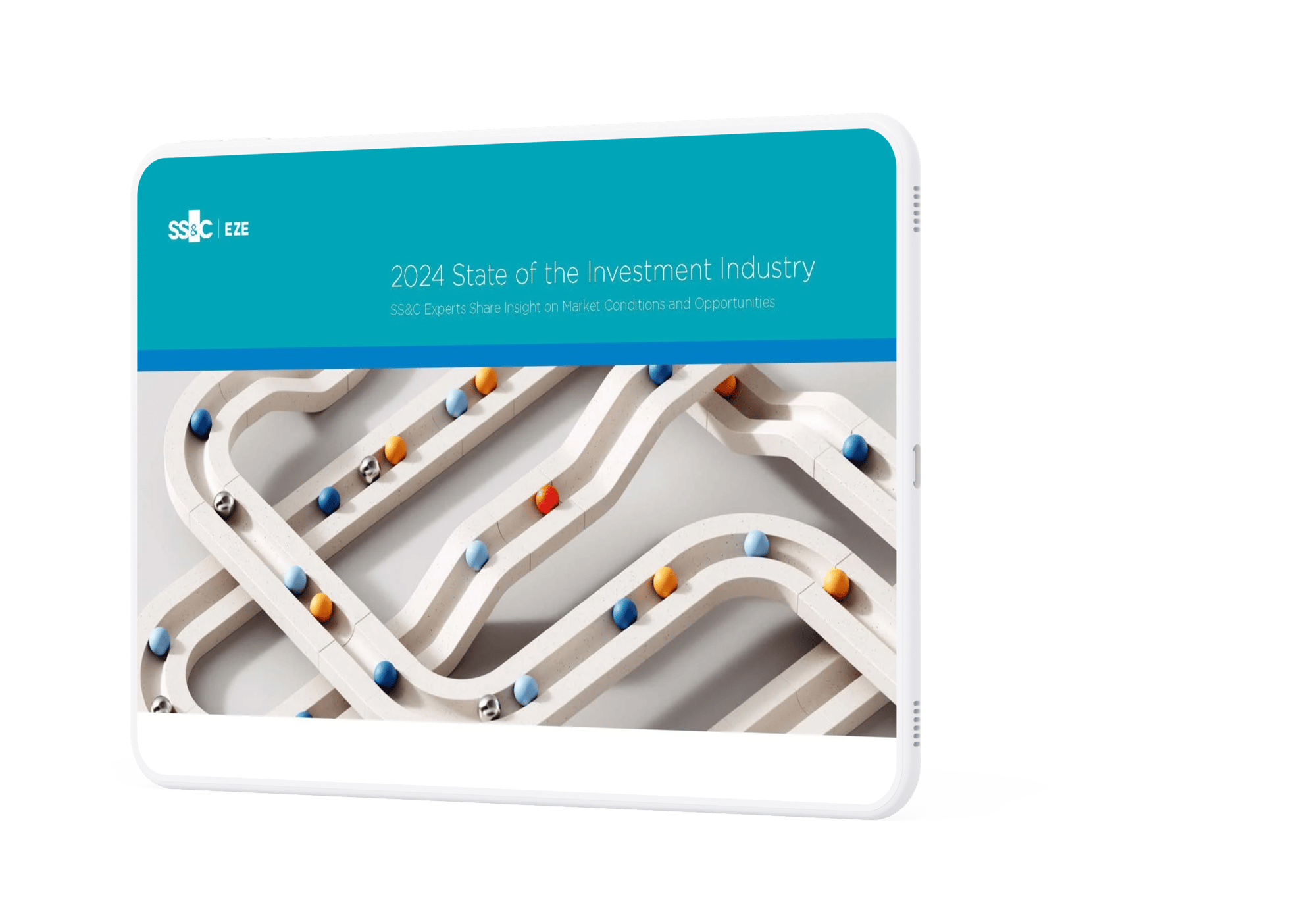
2024 State of the Investment Industry
SS&C Experts Share Insight on Market Conditions and Opportunities
TABLE OF CONTENTS
SS&C Leaders Share Insight into Firms’ Biggest Challenges and Strategic Responses
We asked SS&C’s fintech leaders to provide insight into the headwinds facing the investment industry in 2024 and the tactics firms are using to forge a path in times of market uncertainty.
Read their responses and learn how a combination of creative investment strategies and operational savvy are helping firms navigate the changing nature of today’s markets.
Guidance In Times of Uncertainty
Asset managers, hedge fund managers, and wealth managers are grappling with an unprecedented period of uncertainty.
To help investment firms better understand these markets, we've tapped into the experience of a group of seasoned fintech experts. These SS&C leaders have accumulated decades' worth of knowledge working with investment firms of all sizes – from recently launched hedge funds to large, global asset managers – in a variety of market conditions.
In the following pages, read these market leaders' insights and learn how investment firms are adjusting their investment strategies, assessing operations, forming constructive partnerships, and doing whatever they can to navigate unchartered waters and come out ahead.
Take this ebook with you.
Fill out the form to access a PDF of this trends ebook and have it sent to your inbox for reference later.
6 Headwinds Investment Firms Face in 2024
The year started on a good note, with markets reaching new highs.
However, as Q1 reports showed that inflation was stickier than expected, new concerns emerged about how soon the Federal Reserve would begin lowering rates. The markets took notice.
In 2024, macro-level trends continue to contribute to volatility in global markets.
These trends include geopolitical risks such as the Israel-Hamas war, the Russia-Ukraine war, and US-China competition.
Experts believe the “soft landing” economists were hoping for has been achieved, and a global recession averted.
Still, the global economy is growing slowly.
The International Monetary Fund (IMF) reports that the baseline forecast is for the world economy to continue growing at 3.2 percent during 2024 and 2025, the same pace as in 2023. The forecast for global growth five years from now—at 3.1 percent—is at its lowest in decades.
Increased competition from low-cost, passive ETFs has caused fees to decrease significantly in recent years, yet firms’ costs have remained the same if not increased.
As a result, our team at SS&C sees more firms trying to rationalize costs. They note that this effort is even more challenging as firms simultaneously take on more operational complexity, like expanding asset classes.
This year, firms will need to contend with increased US regulation on reporting and security.
Changes to rules governing funds and new cybersecurity requirements are among the regulatory changes firms must consider when developing governance frameworks.
As Deloitte reports, these considerations will be necessary for entities of all sizes, from private funds to large financial institutions.
Technology enhancements that capture and store data have provided massive amounts of information that firms can use to uncover investment ideas or support investment hypotheses.
Additionally, investment firms can find alternative data on such topics as geolocation or foot traffic reports, credit card transactions, satellite images, and shipping container receipts.
However, many firms face operational challenges that prevent them from accessing data of all kinds and effectively using it. As a result, these firms lose a significant competitive advantage.
Research from PWC projects that by 2027, 16% of asset and wealth management firms will have been acquired or fallen by the wayside. While these firms have traditionally been rewarded for their consistency, as market headwinds continue, transformation is critical to survival.
Subscribe to the SS&C Eze Blog
Modifying Investment and Operational Strategies to Meet the Realities of 2024
Here are some of the top strategies our experts see investment firms employ as they strive to come out ahead in 2024:
Diversification of Assets and Strategies
Investment firms continue diversifying investment strategies and asset classes, with investments in ETFs, SMAs, and fixed income on the rise.
And as firms seek to justify higher fees and find opportunities to grow within the market's constraints, we have seen growing interest in alternative investments like private credit, mortgage-backed securities, credit bank loans, and syndicated bank loans.
Streamlining Operations and Gaining Efficiency as Asset Classes Expand
As firms diversify, many add technical solutions to support each new asset. But all too often, those new solutions introduce labor-intensive processes that hinder operations and increase costs.
To succeed with these additional asset classes, managers need solutions that cater to each instrument's unique requirements while continuing to look, feel, and offer the same institutional-level performance firms rely on when managing more traditional asset classes. These tools should also manage the operational risk and unstructured data associated with complex alternative assets like loans.
Dive deeper into the top 5 challenges firms face in diversifying asset classes – and potential solutions.
Doing More with Less by Outsourcing
While outsourcing is not a new trend for investment firms, what is new is the number of firms choosing to outsource and the scope of what they are outsourcing.
In a survey by BNY Mellon, resiliency and scalability topped the list of priorities for asset managers and owners. To succeed with these priorities, 85 percent of asset managers and owners are shifting operational models and increasing their reliance on service partners and outsourcing.
By outsourcing technology and certain business functions, investment firms can focus on what they do best and leave operational issues like reporting to a trusted vendor.
Read more about how firms are leveraging outsourcing to enhance operational efficiencies and improve the bottom line.
Leveraging Alternative Data in Investment Decisions
Nearly all investment firms we work with say they want to incorporate data science into their investment process.
Coalition Greenwich found that while 73 percent of investors say their use of alternative data has increased over the last two years, 88 percent of buy-side survey respondents see data integration as a critical challenge to data use.
Fortunately, solutions are now available that consolidate the management, reporting and analytics, and data procurement of alternative data. These solutions don’t require additional infrastructure or staff and make it easier for firms to harness the benefits of alternative data in their investment decisions.
The Expertise Firms Need to Thrive in Uncertain Times
Success in today's markets will not come from one singular strategy. Instead, firms will find success by combining a variety of creative investment strategies with operations that empower them to best execute those strategies.
Whether technology, human capital, or data, investment firms must maximize their resources to gain a strategic advantage.
SS&C Eze leaders have decades of experience working with investment firms of all sizes in a variety of market conditions.
Learn how you can put this expertise to work for your firm.
Contact us or visit our website for more information on SS&C Eze’s technology and services.